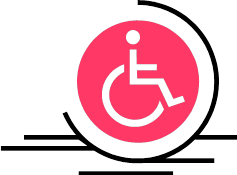If you have disabled persons in your classroom or work area, you should designate volunteers to assist these persons during the evacuation. The type of assistance necessary can vary by the disability. The ACCESS office (805) 378-1461 has evacuation plans and the location of all students on campus with disabilities. Please consult them for questions or instructions.
-
Mobility Impaired
Individuals with mobility impairments and who use wheelchairs may be evacuated using several methods described below. In each case, ask the disabled person which method would work best for them. -
In chair evacuation-(only for non-motorized wheelchairs) Unlock brake, gently lean chair backward and move to edge of first stair step. The helper in front steadies the chair by the rods to which the footrests are attached. The helper at the rear of the chair controls the descent and takes most of the weight of the chair.
-
Office chair evacuation-Transfer the disabled person in-to a sturdy office chair. One helper gently leans the chair backward. The other helper faces the chair and holds onto the front legs. Helpers control the descent by bending their legs slowly and keeping their backs erect.
-
Out of chair evacuation-The helper kneels in front of the wheelchair, his/her back to the disabled individual. Place the disabled person's arms up and over the helper's shoulder and across the helper's chest. Helper then leans forward before standing with the disabled person on his back.
-
Two person-carry side-by-side-The helpers position themselves next to the wheelchair and grasp the other helper’s upper arm or shoulder. The disabled person places his/her arms around the helper’s necks. The helpers lean forward and place their free arms under the individual and firmly grasp each other’s wrists. The helpers descend the steps at the same time side by side.
-
Evac-Chair-Evacuation chairs are available in campus multi story buildings.
-
Hearing impaired
Since the hearing impaired person may not hear the alarms or verbal warnings, the helper should get the attention of the hearing impaired individual by tapping on his/her shoulder or arm. Then direct the hearing impaired individual with hand signals toward a safe exit. -
Visually Impaired
The assigned volunteer tells the visually impaired individual they will help them out of the building. The helper offers his/her right arm for the disabled individual to grasp. Then give clear verbal directions when making turns or going down steps.
